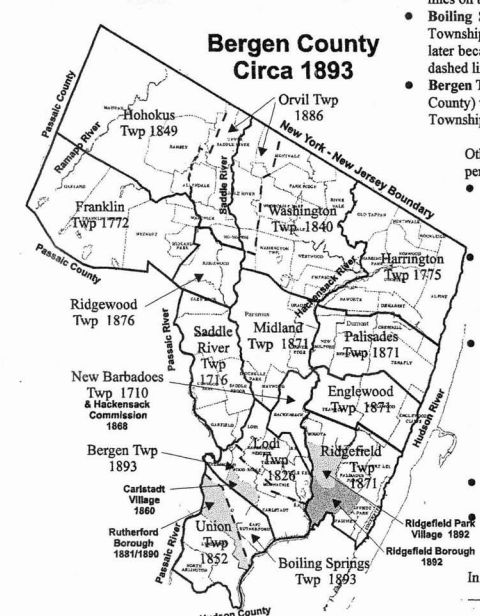How the Brits Helped Us Depart
The rise of townships in Bergen County…..Hmmmmm….Some might suggest that this is an article to assist borderline insomniacs while others might postulate that it is for the anal retentive interested only in the arcane minutia of little known events and connections of many, many years ago. Well, this mighty pen (keyboard) will quickly dispatch those dragons……Hopefully if you remain awake to the end. Hang in and don’t despair as there are some pictures.
I’ll try to answer your first question: What is a township and where did they come from? The answer is that a township is an administrative unit of a larger geopolitical entity such as a county and it reports to the county. Fundamentally, it relieves the county of the day to day minutia of the detailed administration. It also has functions and powers conferred on it by the county such as a place to vote, the development of schools and roads and the collection of taxes to pay for same. A township, as originally developed, is not a town as we know it.
The concept of townships began in England in the 12th Century and was imported to New Jersey by the Brits after they dispatched the Dutch. First, the Brits defined Bergen County and then further defined townships within the county.
In 1693 Bergen Township and Hackensack Township were created and in 1710, New Barabadoes Township came into existence. That’s the same year as when the Ponds Church was founded in Oakland, 66 years before the American Revolution and 192 years before Oakland seceded from Franklin Township. In fact, the Oakland of today originally belonged to Barbadoes Township which then comprised about 85% of Bergen County. Then by 1716, a new townships was created and Oakland belonged to Saddle River Township with a different administrative center. And in 1772 Franklin Township was added to the north of us.
Oakland
So far by 1772 we’re up to 5 townships in Bergen County and it seems that creating townships in Bergen County is a growing business. By 1836 there were 7 townships and Oakland officially became part of Franklin Township with Ridgewood as the administrative center. There were 12 townships in our little county by 1841 and 17 townships by 1893! Was there that much administrating to do in Bergen County? Or, were other forces were afoot to create that number of townships?
Well, as one just might suspect, the forces of local control, tax avoidance and selfish best interest played far more than a minor hand.
The New Jersey Legislature permitted the formation of new townships without the encumbrance of being responsible for the taxes for the schools and roads by the previous township. New townships believed that they could do it better and cheaper than the township they were leaving. They would use the ratable base within the

boundaries of the new township to fund their mandates. Beyond the obvious, this explosion of townships during the 19th Century created an atmosphere of political mobility among all residents of the county and would ultimately fuel Oakland’s departure from Franklin Township.
Let’s connect some dots. In the course of only 57 years, the number of townships in Bergen County went from 7 to 17 and with each addition, there was a new administrative center to collect taxes, build roads, maintain schools and provide a place to vote. The residents of Bergen County were truly asking ‘Who’s on First?’ or ‘Who do we belong to today?’. It’s a mind set thing that creeps into other geopolitical decisions as we will see in 1894.
It was in that year that the sages of the New Jersey Legislature enacted a law that permitted any contiguous number of households to secede from a township without the responsibility of carrying the tax burdens of the township. It became known as Boroughitis as no fewer than 34 towns were almost instantly formed in Bergen County in 1894 alone! We will have a lot more to say about that in a future article.
But suffice to say that by 1893 when townships were being formed at every opportunity, the same selfish best interest mindset was immediately applied to the formation of towns in Bergen County in the following year and subsequent 8 or 9 years. Local grievances were addressed in the form of articles of separation and petitions of incorporation to the legislature. Oakland’s anger at and with Franklin Township was directed specifically at the pharos in Ridgewood who were disregarding and disrespecting Oaklanders at every turn.
And so, folks, here’s what you have been staying awake for: The connection between Great Britain and Oakland’s independence. The Brits invented the system of townships which was maintained but modified by New Jersey after the Revolution which allowed the increase in the number of townships in Bergen County which in turn created an atmosphere of political mobility and local best interest thus encouraging Oakland to secede from Franklin Township in 1902. Whew!
On a macro level, it can be rightly said that there is no such thing as a unique historical event and that all history is inter-connected. On a micro level, without England and their invention of townships, there just might not be an Oakland.
Next week we will learn about David C. Bush, truly the George Washington of Oakland and the founder of our community that we love so much. Se ‘ya then!